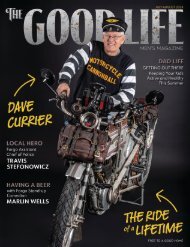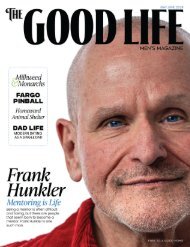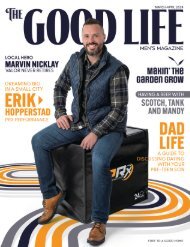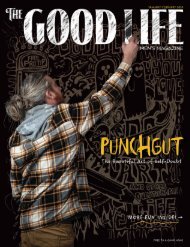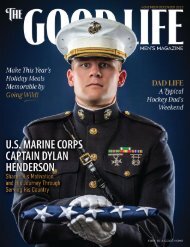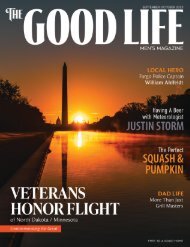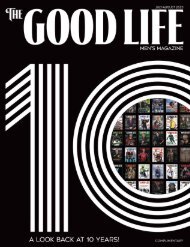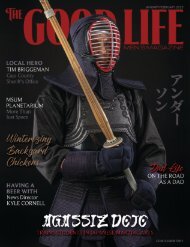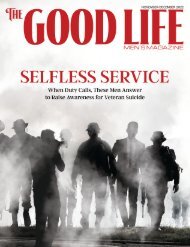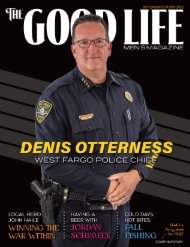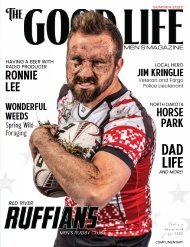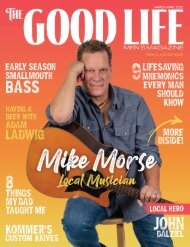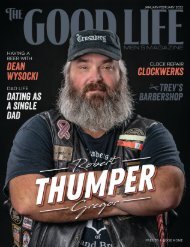The Good Life – September-October 2020
On the cover – Bowhunting: Fun for the entire family. Local Hero donates bone marrow in a lifesaving sacrifice. Having a beer with tv show host Chris Berg and more in Fargo Moorhead's only men's magazine.
On the cover – Bowhunting: Fun for the entire family. Local Hero donates bone marrow in a lifesaving sacrifice. Having a beer with tv show host Chris Berg and more in Fargo Moorhead's only men's magazine.
You also want an ePaper? Increase the reach of your titles
YUMPU automatically turns print PDFs into web optimized ePapers that Google loves.
FATHERS | DAD LIFE
The Anatomy of
the American Soccer Dad
WRITTEN BY: PAUL HANKEL • PHOTO BY: PAUL HANKEL
Monday Evening, 4:24pm
It's the start of the second week of your son's soccer season.
His season OFFICIALLY began last week. However, you
forgot to check the Sports Engine app and forgot.
You would've made it to summer camp on time to pick
him up, if University Drive wasn't perpetually under
construction and gridlock.
WHO SCHEDULES YOUTH SOCCER GAMES TO
START AT 5 PM ON A WEEKDAY?!
You pull up to summer camp and jog inside, hurriedly
finishing up a work call before the screams from inside
summer camp can be heard.
Your son excitedly greets you. He, of course, wants to finish
the project he's working on, but you remind him that his
soccer game starts in 32 minutes and that he still needs to
change and eat.
You hustle him into the bathroom to change. Once
changed, he promptly informs you that he has to poop.
While pooping, your son launches into a lengthy dialogue
about Fortnite's latest update. You listen attentively
because we love our children.
Once done, you hurriedly try to help him wash his hands.
He reminds you, "DAD. I have to scrub them for TWENTY
SECONDS to get the germs off!"
Oh, so NOW we're all about the rules?
5:01 pm
You plop down into your collapsible chair and perform a
quick dad inventory:
Sunglasses – $12 from Holiday. Because you're a father
now and can't be about that $100 Ray-Ban® life.
Shoes – Stylish enough to let everyone know you didn't
buy them for yourself, but sporty enough to let everyone
know you dominated the pitch in 6th-grade soccer. No
socks because it's laundry week.
Slacks – Costco brand, $20. Dressy enough to wear to
work meetings, with enough built-in flex to let you play
soccer with your son after the game for 30 seconds before
you get sweaty and run out of breath.
Coffee – $1 and also from Holiday. Because, again, you're
a father and can't be about that $7 Starbucks life. Its
Guatemalan Blend, and 100 percent Fair Trade organic,
because you do what you can to love mother earth.
Blue collapsible chair – A MUST. Purchased for $14.99 at
Gander Mountain's going-out-of-business sale. Double cup
holder, with a triple-stitch, reinforced backrest. The GOLD
STANDARD of collapsible chairs.
5:21 pm
Pretty good competition so far. The other team has a kid
who you just KNOW isn't 8 years old and is a good two
inches and 15 pounds bigger than everyone. You make a
mental note to text the coach about it.
Speaking of which ... you've decided to not coach your
son's soccer team for several reasons:
You have no idea how to play soccer, other than playing in
junior high. You disguised this fact by claiming that you
wouldn't be able to be at all the practices and games, due
to work. When, in reality, nowadays you only watch soccer
every four years during the Olympics. And that usually
entails using false patriotism as a guise to get hammered
at inappropriate hours during the day. You sit on a pitch
of LIES.
The other reason you don't coach is that, in the interest of
child development and everyone having fun, this particular
soccer program doesn't keep score. Which is a decision
backed by sports scientists, child psychologists and most
coaches. However, you never bought into this whole,
"everyone gets a trophy," mentality and, therefore, keep
track of the score in your head. It's about WINNING, gosh
darn it! You decline to coach out of protest.
5:30 pm
Halftime.
2 / THE GOOD LIFE / urbantoadmedia.com
Your son trots over, and you force him to consume some
water. He promptly dumps most of it on his head because
he's hot. You swear under your breath because you left
his $32 Under Armor water bottle sitting on the kitchen
counter this morning and now had to pay GAS STATION
prices for a bottle of water on the way to the game. Also,
maybe your son would not be so hot if he'd agreed to get
a haircut like you've been asking him to for two months
now?
Your son gloats over how many goals he's scored. You
vocally remind him that, "We're just here to have fun.
Goals don't matter," while, in your head, thinking, "He's
the next Neymar."
Your son tells you that the one big kid on the other team
isn't even good and is trash.
You remind him that we don't name call in this family.
6:08 pm
You impatiently navigate the line to exit the parking lot.
"WHY IS THERE ONLY ONE %$@#! EXIT?! What
MORON designed this parking lot?"
"DAD, we don't name call in this family!"
As you cruise home, you smile in anticipation of the
ensuing fight regarding why a smelly eight-year-old boy
has to shower after a day of playing outside and then
playing an entire soccer game.
You tell yourself that you're going to be firm and enforce
the rules. However, in the back of your mind, you know that
the inevitable compromise will stem from the promise of
extra screen time before bed.
This is dad life. •
5:58 pm
The game ends and you almost have a mini heart attack
because you thought it was your week to bring the postgame
snack. Thankfully, it wasn't.
You trot out onto the pitch and fire a few rockets at your
son, who is in the goal. You quit after a few minutes, to
avoid sweating. As before mentioned, it is laundry week
and you have every intention of wearing these same pants
again later in the week.
You congratulate your son and he tells you that he,
"dominated that trash kid in the second half."
Again, we don't name call in this family.
urbantoadmedia.com / THE GOOD LIFE / 3
CONTENTS
SEPTEMBER-OCTOBER 2020
Volume 8 • Issue 2
2
6
10
16
18
24
26
30
32
FATHERS - DAD LIFE
The Anatomy of the American Soccer Dad
ALZHEIMER'S AWARENESS
What it Means to Me
DRIFTING
Not Just Smoke and Mirrors
MEN'S HEALTH
4 (Easy) Ways to Boost Immunity
ON THE COVER
The Lure of Bowhunting
ASK 30 WOMEN
Aren't You a Little Old for That?
HAVING A BEER (WATER) WITH
Chris Berg
TAMING THE RAIN
One of the Easiest Things a Homeowner
Can Do is to Install a Rain Barrel
LOCAL HERO - NICK STENZEL
A Lifesaving Sacrifice
Local Donor Matches with Anonymous
Stranger
18
ON THE COVER
THE LURE OF
BOWHUNTING
4 / THE GOOD LIFE / urbantoadmedia.com
PUBLISHED BY
Urban Toad Media LLP
www.urbantoadmedia.com
OWNER / PHOTOGRAPHER
Darren Losee
darren@urbantoadmedia.com
OWNER / GRAPHIC DESIGNER
Dawn Siewert
dawn@urbantoadmedia.com
CONTRIBUTING WRITERS
Meghan Feir
Alexandra Floersch
Ben Hanson
Paul Hankel
Jeffrey Miller
Krissy Ness
ADVERTISING INQUIRIES
Darren Losee
darren@urbantoadmedia.com
READ A PAST ISSUE
yumpu.com/user/thegoodlife
FOLLOW US ON FACEBOOK
facebook.com/urbantoadmedia
FOLLOW US ON TWITTER
@urbantoadmedia
FOLLOW US ON INSTAGRAM
@urbantoadmedia
The Good Life Men’s Magazine is distributed six times
a year by Urban Toad Media LLP. Material may not be
reproduced without permission. The Good Life Men’s
Magazine accepts no liability for reader dissatisfaction
arising from content in this publication. The opinions
expressed, or advice given, are the views of individual
writers or advertisers and do not necessarily represent
the views urbantoadmedia.com or policies of The Good / THE Life GOOD Men’s Magazine. LIFE / 5
Alzheimer’s Awareness
What That Means to Me
WRITTEN BY: KRISSY NESS
If you are like me you had never heard
much about Alzheimer's disease until
it directly impacted your everyday
life.
At first, I was shocked at how little I
had heard of it because of just how
devastating the disease is, but as it
began to rear its ugly head into my
life I understood a little more why I
hadn't heard first hand what it is all
about.
"Alzheimer's disease is a
degenerative brain disease and is the
most common form of dementia. It
is important to note that dementia
is not a specific disease; it is an
overall term that describes a group
of symptoms," according to the
Alzheimer's Association's website.
There is no particular reason
someone develops Alzheimer's
disease. It can be a multitude of things
Alzheimer's disease
is a degenerative
brain disease and is
the most common
form of dementia.
It is important to
note that dementia
is not a specific
disease; it is an
overall term that
describes a group
of symptoms.
including age, genetics, environment,
lifestyle, and/or coexisting medical
conditions.
This disease intruded into my life so
rapidly and yet it is slowly taking away
one of the most important people in
my life. One thing I didn't understand
until enough time had passed is that
you don't see it coming. Silly mistakes
and forgetfulness seemed slightly out
of place but weren't causing major
issues in day-to-day activities. It isn't
until you have seen the progression
do you start to realize something isn't
quite right.
According to the Mayo Clinic's
website, "Alzheimer's disease begins
long before any symptoms become
apparent." As of today, there is no
test you can take to tell you if you will
be affected and there is no cure if you
develop it, although trials and studies
are working towards both.
6 / THE GOOD LIFE / urbantoadmedia.com
As devastating as that is there are
ways you can help those affected
by the disease and those caring for
them, right here in our community.
"The Alzheimer's Association
is an organization dedicated to
accelerating global research, driving
risk reduction and early detection,
and maximizing quality care and
support," according to their website.
There is a chapter dedicated to
Minnesota and North Dakota with
As devastating as
that is there are
ways you can help
those affected by
the disease and
those caring for
them, right here in
our community.
offices right here in Fargo,
among other locations.
Each year they host The Longest
Day on June 20th, which is the
summer solstice. According
to their website, "People from
across the world will fight the
darkness of Alzheimer's through a
fundraising activity of their choice."
They also host The Walk to End
Alzheimer's every September,
Alzheimer’s
Top 10 Early Signs
Memory Loss
Social
Withdrawal
Changes
in Mood
Decreased or Poor
Judgment
Misplacing
Belongings
Struggling to
Communicate
Hard to Complete
Familiar Tasks
Confusion of Time
and Place
Changes in
Vision
urbantoadmedia.com / THE GOOD LIFE / 7
Alzheimer's disease begins
long before any symptoms
become apparent.
although this year will look a
little different due to our current
circumstances.
This year, the walk will take place
on September 26th, and instead
of a large group walk around the
Red River, people are encouraged
to sign up for a team and walk in
small groups to raise money and
awareness. You can sign up for a
team or register your existing team
on their website.
Due to our present situation support
groups have been put on hold but the
Alzheimer's Association is available
24/7 at 1-800-272-3900 for around
the clock care and support and our
local chapter is open 9 am to 4:30 pm
Monday – Friday at 701-277-9757.
Although this disease is tragic for the
individual affected, the toll it takes
on the friends and family, especially
the primary caregiver, is devastating.
I can only speak for myself when I
write this, as a daughter to a primary
caregiver and their spouse, but you
find yourself in a constant state of
grief and guilt – wishing there is
something you could have done or can
do to make this all go away.
There has been one phrase that I have
kept with me from the very beginning
of this journey, you will go through the
five stages of grief a thousand times
before this is over.
At first, I didn't know what that meant
but three years into this disease I now
understand. There are stages in this
"You will go
through the
five stages
of grief a
thousand times
before this is
over."
8 / THE GOOD LIFE / urbantoadmedia.com
disease and they are not clear-cut in any way. One day
the affected may be completely "with-it" and the next day
has no idea what's going on, so you find yourself getting
your hopes up only to have them dashed over and over
again. It is critical to accept the situation at hand and
understand that although some days are better there is
no going back.
FIVE STAGES OF GRIEF
Stage 1 – Denial. When you first hear the
diagnosis, you may deny its accuracy,
continue to expect your loved one to
get better, or convince yourself that the
symptoms are not Alzheimer’s.
Stage 2 – Anger. You may be angry with
the person or with the disease itself.
You may easily become frustrated or
feel abandoned and resentful toward
family members.
Stage 3 – Guilt. You may regret previous
actions, or harbor negative thoughts
about your loved one.
Stage 4 – Depression or sadness. You
may lose hope, withhold your emotions
or even withdraw from social activities.
Stage 5 – Acceptance. This occurs
when the patient’s loved ones ultimately
acknowledge the diagnosis. It's possible
you can find meaning in caring for your
loved one. You can learn to enjoy the
remaining time you have together.
If I could give anyone reading this who is affected by this
disease a piece of advice is to take the time for you. You
can't give the kind of support your loved one needs if you
are in a low place.
Throughout this experience, I have learned that my
family is resilient and my community has stepped up
to provide support at every turn. Whether it is support
groups, fundraising events, or conferences, people want
to help and that is a beautiful thing.
Of course, you can find many other fundraising
opportunities throughout our community.
Head over to the Alzheimer's Associations website at
www.alz.org to see where you can provide help. •
urbantoadmedia.com / THE GOOD LIFE / 9
10 WRITTEN
/ THE GOOD
BY: KRISSY
LIFE
NESS
/ urbantoadmedia.com
• PHOTOS BY: URBAN TOAD MEDIA
urbantoadmedia.com / THE GOOD LIFE / 11
If you are like me, you have only seen drifting in the movies. You
think, well I can pull my E brake and slide around the corner on
an icy road, it can't be that hard. Boy, is that all wrong.
According to Ethan "DK" Seigel and every other drifter out there, sliding on ice
doesn't mean a thing. There is a certain precision and technique that allows
you to be a competitive drifter.
ND Drift promotes events at the drift course at Interstate Raceway near
Sabin, MN. If you hop over to the ND Drift Facebook page you can catch
video coverage and photos of past events and find out just exactly what it
means to drift competitively.
Matt Sandbeck and Ryan Keller operate Interstate Raceway, while Max
Crocker and Darin Smith are on top of all the promotional content for
ND Drift. The drift track has been operational since 2018.
Due to the way competitions are held there are many levels of
drifters, the beginner level is also known as grassroots. Grassroots
competitions are held monthly and the season points winner will
walk away with $1000. Additionally, ND Drift signed on with
Formula Drift, which allows them to host a "Pro-Am Shootout"
which means the top three places at the event will receive their
Pro 2 license. The winner will also walk away with $10,000! The
2020 Pro-Am Shootout will be held August 20-23.
12 / THE GOOD LIFE / urbantoadmedia.com
"Once you receive your pro license you can enter pro
events for Formula Drift," said Seigel. "Last year we had
people from Florida, Texas, and Pennsylvania traveling to
our event to try and win the money and to try to win the
pro licenses. A lot of these guys, that's what they do, they
chase money and chase licenses because some of them
also run the Formula Drift series."
Seigel not only works for Interstate Raceway but he also
drifts cars. You can find him announcing drift battles on
the clock, and creating smoke on the track off the clock.
Currently, he is driving a 2008 bright yellow Corvette.
Now, you may be asking yourself why on earth would you
take a Corvette out on the drift track? It is bound to crash
into the wall at some point. Who has the money?
"Corvettes are getting cheaper and affordable enough to
become drift cars," said Seigel "Typically you wouldn't
grab a $30,000 car, right? Yeah, so they're getting down
to the five to $15,000 range where it's effective to grab
one and companies are making the drift parts for them."
The most popular cars you will see out on the track are
usually a Nissan 350Z and Nissan S13 and S14. You
are looking for a car that has rear-wheel drive, a manual
transmission, and preferably a bigger motor; this is why
the Corvette works well for this sport — it already comes
with a large motor.
When you are drifting in a competition you have a lead
driver and a follow driver. Essentially the leader decides
urbantoadmedia.com / THE GOOD LIFE / 13
14 / THE GOOD LIFE / urbantoadmedia.com
the course of action of how they are
going to turn and how they are going
to work the track, while the follower
has to stay as close to that car without
hitting it and mimic the actions of
the leader. Both drivers get a turn to
lead and to follow. A panel of three
judges determines the winner of the
competition.
If you head over to interstateraceway.
com you can find the current schedule
for this year's season. Typically there
would be more dates but as we all
know there are a lot of limitations this
year. What is great about events like,
Drifting the Plains, is that you can
spend all weekend watching the races
and just hanging out and enjoying the
event.
Spectators can participate in 'ridealongs'
where you actually get to take
a ride with a driver on the track. How
cool is that? You can bet you will find
me out there someday soon trying to
catch a ride around the track while
screaming for my life.
If you are ever going to do something a
little wild and out of your comfort zone
this is the place to do it. Of course,
you are paired up with an experienced
driver and are required to wear a
helmet, and the only stipulation is that
you have to be 13 or older. So grab the
kids and bring them out to the track for
some fast action drifting.
"Drifting is the fastest growing
motorsport in the United States. I can
see why, having been involved in it for
a couple of years now. It's crazy," said
Seigel. Do yourself a favor and head
over there for some excitement; you
might even see me cheering on the
sidelines. •
urbantoadmedia.com / THE GOOD LIFE / 15
MEN'S HEALTH
4 (Easy) Ways to
BOOST IMMUNITY
WRITTEN BY: BEN HANSON
Pandemic or no pandemic, fall brings an annual
onslaught of airborne germs. As kids (hopefully, safely)
return to class, lake cabins close up and outdoor
activities slowly move inside, healthy habits will be ever
more necessary to guard against not only the continuing
challenge of this virus we call COVID, but against the
yearly cold and flu bugs as well.
The added precautions many of us have incorporated
into our daily routines — social distancing, maskwearing,
extreme online shopping — will translate well
into cold and flu season. For those lucky enough to be
able to continue working remotely, you will also get to
avoid that petri dish we call "the office."
But it seems these adjustments to normal life are
unsustainable. People are getting antsy. We want out
of our homes and back to normalcy. Many are reluctant
to put on a mask (even here in the Midwest, where
five months out of the year we're covering up every
bit of exposed skin as possible … presumably to keep
ourselves safe). So knowing that, and realizing it may
not be possible to rely on your fellow human being to
accept slight inconveniences for the common good,
what's the next best thing?
any food — even the so-called "healthy" alternatives labeled
as low-calorie, low-fat and even organic.
"Even what is typically considered healthy or organic can
have loads of sugar in it," Sauer said. Sugar also goes by
many names, so do a quick Google search and familiarize
yourself with all of sugar's secret identities before making
your next grocery list.
Personal accountability. Again, pandemic or no
pandemic, the following advice on how to keep your
immune system in top shape is common sense you
can embrace now to give yourself an edge. These steps
below are easy and effective — kind of like wearing a
mask. (Sorry, couldn't resist … no more cheap shots, I
promise).
Dr. Forrest Sauer, founder of Twin Oaks Health
Solutions in Fargo, shared his top four immuneboosting
tips that are equally applicable to both men
and women. Heading into the cold and flu season, he
recommends focusing on the basics to keep your body
healthy, energized and as resilient as possible.
Reduce Your Sugar Intake
Those pesky bacteria and viruses love to feed on sugar,"
Dr. Sauer said. "Sugar gives those germs superpowers."
He cautioned, however, not to make quick, uninformed
dietary changes. Instead, he advised to read labels
carefully and understand that sugar can hide in almost
Get to Bed
Blow out that midnight oil and go to bed," Sauer said
vehemently. "Getting enough sleep will give your body
enough rest and recuperation for it to de-stress and reset
the immune system for another day."
Sleep is also an important component of maintaining your
mental and emotional health. A drained body cannot fight
back as well against environmental contaminants, nor is it
well equipped to deal with stress … which we're all dealing
with now perhaps more than ever. Establish a routine. Give
yourself a bedtime, and stick to it.
16 / THE GOOD LIFE / urbantoadmedia.com
Drink More (Water)
Think of water as the grease your body needs to work
and move," Sauer said. "No greasy, no move-y," he said
with a chuckle.
This is the easiest step of all. Water is a precious
resource, but also a plentiful resource. Find yourself a
favorite water bottle and keep it on you. It should become
an extra appendage, never leaving your side.
"I drink 20 oz. of water every morning before I get to
work, and then another 20 oz. when I get to the office,"
Sauer explained. "Your body craves at least half of your
body weight in ounces of water every single day."
Boost Your Biome
A healthy gut = a healthy body. Your internal microbiome
is filled with millions of healthy bacteria, but there is a
balance that needs to be kept. Hearkening back to tip
number one, too much sugar, for example, can feed the
wrong kind of bacteria in your gut and leave your immune
system compromised.
"Gut health goes far far beyond a probiotic, but taking a
daily probiotic before bedtime on an empty stomach is a
"best practice" first step," Sauer said. "The majority of
your immune system is found in your gut, so you need a
healthy gut to fight off those bad bacteria and viruses." •
Special thanks to Dr. Forrest Sauer at Twin Oaks Health Solutions,
medical consultant for our Men's Health section.
urbantoadmedia.com / THE GOOD LIFE / 17
ON THE COVER | BOWHUNTING
WRITTEN BY: JEFFREY MILLER • PHOTOS BY: URBAN TOAD MEDIA
18 / THE GOOD LIFE / urbantoadmedia.com
The coolness of the evening was settling over the forest. As the sun kissed the horizon, the sound of shuffling footsteps
drifted my way. Straining to see through the ever-darkening gloom, I was nonetheless surprised when a deer appeared
in the underbrush. The doe fed around my stand on fallen acorns, so close I could see her jaws working as she crunched
on the treats. At less than 30 feet, I could nearly see her individual eyelashes. While I didn't draw my bow, the ultra-close
encounter, with one of the Earth's most beautiful creatures, is what bowhunting is all about.
Archery is a past-time that is approachable to people from all walks of life. Men, women and children can fall under the
spell of the flying arrow, and today it's easier than ever to get properly equipped.
urbantoadmedia.com / THE GOOD LIFE / 19
ON THE COVER | BOWHUNTING
First and foremost, the bow must
be selected. There are three types of
bows; the compound, the recurve and
the longbow. The longbow is familiar
to anyone who knows of Robin Hood.
A simple piece of laminated wood, the
longbow is bent in a D-shape when
strung. The recurve bow is similar to
the longbow, with the exception of the
ends of the bow limbs are curved. This
small mechanical advantage increases
the efficiency of the longbow design.
Finally, the most familiar bow is the
compound bow. Based on a block-andtackle
design, the compound bow is
far and away the most popular design
used today.
“Archery is a past-time that is
approachable to people from
all walks of life.”
The best place to begin the search for
your new bow is a dedicated archery
shop. Bows are uniquely individualist
tools, which may work great for me but
be nothing but frustration for the next
shooter. An archery shop will provide
the place to shoot a variety of bows and
help to select the gear that works the
best.
20 / THE GOOD LIFE / urbantoadmedia.com
It has been said that
archery is 95% mental
and 5% physical.
Once an archer can
physically draw the
bow back, the ability
to shoot accurately
and consistently lies
between their ears.
Bows, like most other things in life,
are expensive. Top-of-the-line flagship
bows carry top-of-the-line prices, but
mid-level bows shoot well and carry a
lower price tag. Don't be afraid to buy
a good used bow and use the savings
to buy the rest of your kit. Arrows are
the next most important part of the
gear, requiring the correct length and
weight to shoot accurately. Rounding
out the essential gear needed is a bow
sight and arrow rest. With the required
gear in hand, it's now time to hit the
range and start shooting.
It has been said that archery is 95%
mental and 5% physical. Once an
archer can physically draw the bow
back, the ability to shoot accurately and
consistently lies between their ears.
Numerous books have been written
about the mental side of archery. For
a beginner, consistency is the most
important factor in shooting well.
The string needs to be drawn to the
same location on the face each time.
The repetition is similar to a baseball
player's swing. If the batter buries the
end of the bat deep in their hand on one
swing, and then chokes up on the next,
the bat speed and angle will differ. If
the anchor point on the archer's face is
different each shot the arrows have
no choice but to fly awry.
urbantoadmedia.com / THE GOOD LIFE / 21
ON THE COVER | BOWHUNTING
Between my significant other Melanie
and I, we have four children. All are
interested in archery, and each has a
bow that fits them. Our oldest is 11,
and she shoots a bow with a wide
range of adjustments. With nothing
more than an Allen head wrench, I can
adjust her draw-length by 10 inches
and her draw weight by 40 pounds.
This is important for a growing child,
as we have already increased her draw
by 4 inches and weight by 15 pounds
in the first year she has shot.
The other kids shoot bows with less
adjustment and are learning basic
archery form. Most people can't pick
up a bow for the first time and shoot
bullseyes. Repeated, consistent
practice prepares the archer for
dependable accuracy down the road.
Of course, the first task for any archer,
young or old, is to practice safety.
Archery gear can be every bit as
dangerous as firearms to the careless
shooter.
Hunting with a bow is a much different
task than simple target shooting, and
the best practice is on life-size foam
animal targets. In Fargo-Moorhead,
there are a couple of archery clubs
that have ranges consisting of multiple
foam animal targets in realistic
shooting conditions. We are fortunate
to live on a rural acreage with plenty
22 / THE GOOD LIFE / urbantoadmedia.com
of space for targets. We shoot at a variety of distances,
through trees and grass, to mimic the actual hunt.
Once an archer sets foot in the woods, properly licensed
and with sharp broadheads on their arrows to pursue
wild game, the stakes are raised. A poor shot on a target
will elicit nothing more than a ribbing from your fellow
shooters. A poor shot on a game animal can mean a long
trailing job and recovery. We owe it to the animals we
pursue to shoot accurately. A properly placed broadhead
arrow, placed in the chest of a big game animal, will
dispatch the animal within seconds. My oldest daughter,
even though she is shooting enough poundage to hunt
deer, has decided she isn't ready mentally to hunt.
Shooting foam targets and flesh-and-blood critters are
world's apart, and the pursuit shouldn't be taken lightly.
Fortunately, most bowhunters enjoy mentoring
beginners. If you are interested in bowhunting, seek out
a local archery shop for your gear, and an experienced
hunter as a guide. While there are plenty of books,
magazines and websites about bowhunting, learning
from experience will pay dividends in the field. The
lure of bowhunting is just as strong today as it was
for our ancestors who depended on the bent stick for
their survival. The flight of the arrow is burned into
mankind's soul. •
urbantoadmedia.com / THE GOOD LIFE / 23
ASK 30 WOMEN
Aren't you a little
old for that?
Age is just a number, right? The older you get you should be able to do as you choose, or so you think.
We asked 30 random women, what does he do that has you asking, “Aren’t you a little old for that?”
Gentlemen, you may or may not be too old for the following:
1
When he drinks
Mountain Dew for breakfast.
2
Drinking all the time.
3
He's too old to listen to
Demi Lovato. It’s creepy.
4
He still asks for help for simple things
– like putting in eye drops.
5
You’re too old to
sit in the kiddie pool with the dogs.
6
Collecting wresting figures.
24 / THE GOOD LIFE / urbantoadmedia.com
7
Going to the club,
the kids are calling you the old guy.
8
Acting like a rebellious teen. We need
to follow at least some of the rules.
9
#1 Answer!
Playing video games
and screaming at the TV.
10
Trying way too hard to win
at games and sports.
11
Not throwing away trash. Seriously,
the counter top is NOT the garbage can.
The trash is only two feet away
12
Using the trending words, like ‘fleek’
You don’t even know what that means.
13
Eating a whole family-size candy bar
(Yes. Not king size… the one even bigger
than that, that looks like a movie prop)
basically while getting ready for bed.
14
Wearing obnoxious
white stitched jeans.
15
Wearing knit hipster hats
in the summer.
16
2-year-old boy humor.
Many eye rolling moments here.
Boobs, butts and fart jokes.
17
Having his mother pay for things.
18
Eating after 7pm. You know you’ll get
heartburn, yet you still do it.
19
Wearing skinny jeans.
20
He is still living at home
with his parents.
21
Going out and partying with your
bro’s. You have children and you have to
work in the morning, and it’s Tuesday.
22
Never running out of Doritos.
23
Having terrible friends.
24
Collecting car magazines
that never really get read.
25
Hangovers.
26
You don’t need that big Nerf gun.
And why do you have a budget
for Nerf guns?
27
Getting into fights at the bar.
28
Doing Jello shots - or any shots. Playing
beer pong - or any drinking games.
29
Sleeping in later than 10 am.
30
Living in a "bachelor pad". Don't hang
posters in your living room.
urbantoadmedia.com / THE GOOD LIFE / 25
HAVING A BEER WITH | CHRIS BERG
HAVING A WATER
with chris berg
WRITTEN BY: MEGHAN FEIR • PHOTOS BY: URBAN TOAD MEDIA
After graduating from Stanford University (and Fargo South High School
before that), Chris Berg immediately began using his talents, charisma, poise
and voice in as many ways as he could. Over the years he’s traveled around
the country doing promotional seminars on stage for the Tony Robbins
motivational speaking tours, worked with high school students to help them
attain college scholarships and leadership skills, and had a radio show on AM
1100 The Flag. For the past 8 years, he’s been the host of “Point of View” and
“North Dakota Today” on KVLY.
On a Monday afternoon in July, I had the pleasure of chatting with Berg via
Zoom as he drank what Drekker is best known for — their water (totally
kidding, but hey — he had to go to work soon).
Along with his impressive professional history, I had the opportunity to learn
more about Berg’s fascination with Latin culture and his love for Minnesota’s
pride and joy, Prince. He regaled me with tales of landing serendipitously on
the set of some of the most popular TV shows of the ‘90s, and he told me,
in the most concise and meaningful way possible, what living the good life
means to him. Read on to learn more about local legend, Chris Berg.
Good Life: What would a perfect day look like for you right now,
in this moment?
Chris Berg: To be able to wake up near a beach, preferably in Mexico.
I’d take in some sun and then get ready for my shows, kind of like this
— doing it via the distance, whether it’s on Zoom or something else.
Would I want to do it indefinitely that way? I’d like to be in the studio
at times, but at this moment in my life, I’d love to have that kind of
freedom and flexibility.
GL: Okay, Chris. So we’re in, like, the third wave of mullets being
popular, so I’m curious what you think about that trend.
CB: Party in the back, business in the front? Well, I’m always for more
freedom, so if you want to rock a mullet, more power to you.
GL: Would you ever try to pull off a mullet?
CB: No. Not unless I could wear it like Prince and it was all curly on top.
26 / THE GOOD LIFE / urbantoadmedia.com
GL: Where else in the
world do you think you
would fit in the best
culturally, climate-wise—
everything?
CB: One thousand percent
Mexico or Buenos Aires,
Argentina. I wish I could
explain it to you. I’ve just
always had this affinity for the
Latin culture, the people, the
vibe, the area, obviously the
beautiful weather, the food,
the language — I could go on
and on and on. I don’t know
what I’d be doing down there,
but it all just resonates with
me.
GL: If you could interview
anyone, who would it be
and what would you ask
them?
CB: Jesus Christ, and I’d ask him
what it was like doing all those
miracles in front of people and
still not having them believe
in you. That would be my
first question for him. Then
I’d be like, “What did you say
to doubting Thomas when
you came back after being
crucified and you’re standing
in front of him and he’s like,
‘Nah, I don’t think so’?”
GL: Yeah, really. It does make
me feel better about my
occasional doubts because
Thomas was literally right
there in front of Jesus.
CB: Exactly! He feeds 5,000
people and Thomas is like, “I
don’t know, man.”
GL: Maybe he had really shortterm
memory issues and was
just always like, “Oh, you’re
right. I kind of forgot about all
that.”
urbantoadmedia.com / THE GOOD LIFE / 27
HAVING A BEER WITH | CHRIS BERG
“One time I ended up on
the set of “Frasier” and
“Will and Grace.”
GL: Dawn and Darren want me to ask you about
“Will and Grace,” and I don’t know why. Tell me
about it, Chris.
CB: Speaking of miracles, that was one. I was in LA
and I had a couple of pinch-me moments. One time I
ended up on the set of “Frasier” and “Will and Grace.”
With the “Frasier” thing, I happened to be there the
week of the 200th episode airing. I got to go to this
event where anybody associated with “Frasier” was
there and it was like, “Is this really happening in my
life right now?”
GL: If you had to be stuck on a deserted island
for three years and you couldn’t be with a
family member or friend, with whom would you
choose to live on the island?
CB: Prince. I think he’s amazing. And when you get
bored, he could just grab some coconuts, turn them
into instruments and you could be like, “Okay, give
me some ‘Raspberry Beret’ with those coconuts.”
GL: And the saltwater would keep his curls in really
nice shape. What’s your favorite Prince song?
CB: It depends on my mood, but I will say this: I think
one of his most underrated albums is “Sign of the
Times.” He has a ton of great jams on there. “Purple
Rain” just dominated, but I thought “Sign of the Times”
was incredible. Are you a big Prince fan or not really?
GL: Not really, but most Minnesotans are, so I’m an
anomaly.
GL: What smell do you hate the most?
CB: I don’t know, but sour milk comes to mind.
GL: Does anything instantly make you nauseated
when you smell it?
CB: I mean, I try to avoid that stuff so much that
nothing really comes to mind.
GL: You mean you actually take the garbage out
before it starts smelling? Wow.
My grandpa. He’s just a solid human
being. He’s one of those guys who’s
always pleasant to be around.
28 / THE GOOD LIFE / urbantoadmedia.com
GL: In 30 years, what do you
think you’ll wish was popular
or in use again that probably
won’t be?
CB: Breakdancing.
GL: Can you breakdance?
CB: Oh, I’ve got a mad head spin.
GL: Who do you admire most
and why?
CB: My grandpa. He’s just a solid
human being. He’s one of those
guys who’s always pleasant to be
around. He just gets it. Everyone
says how much they love my
gramps. He was always there for
me when I was growing up.
GL: What’s been your favorite
professional memory?
CB: Interviewing President Donald
Trump. I’ve been blessed and been
able to do it three times, twice in
Fargo and once in D.C. It’s a trip.
The guy’s just super gracious. I
think the second time we did it he
walked up and said, “Hey, I hear
you’re pretty good at football,” and
he was just super cool and funny.
GL: What does living the
good life mean to you?
CB: Living out your God-given
destiny.
GL: How do you think people find
out what their God-given destiny
is?
CB: I think you just pray about it
and ask God to use you every day
and see where He puts you. •
urbantoadmedia.com / THE GOOD LIFE / 29
Taming the Rain
WRITTEN BY: JEFFREY MILLER
There is something about the whisper of gentle rain on a
summer evening. A low hum emits from the earth as the
ground soaks up the life-giving moisture. But what happens
when the water runs off, instead of soaking into the soil?
Pavement and concrete abound in Fargo-Moorhead, and
rainwater runs quickly off these surfaces straight into the
storm drains. Carrying everything from silt and clay to oil and
other pollutants, the contaminants soon find their way to the
Red River. The myriad of life in the river is affected by this
influx of microscopic debris. Our drinking water is affected
as well.
ONE OF THE EASIEST THINGS
A HOMEOWNER CAN DO
IS TO INSTALL A RAIN BARREL.
There are steps we can take to reduce the effect of polluted
runoff. One of the easiest things a homeowner can do is
to install a rain barrel. A rain barrel is merely a 55-gallon
barrel perched near a downspout coming off a home's roof.
A tremendous amount of water rushes off a typical home
during a rain event. For instance, a half-inch of rain falling
on a 1,000 square foot roof will result in over 300 gallons
of water. When the barrel is full, a diverter will drain off the
excess water.
The harvested water can be used in a variety of places.
Rainwater is better for plants as it has a superior purity and
30 / THE GOOD LIFE / urbantoadmedia.com
softness compared to tap water, as well as being free from
chlorine, salts, minerals and other contaminates. Irrigation
for lawns and gardens accounts for a healthy percentage of
household water usage each growing season. Not only does
the rainwater contribute to healthier growth in plants, but it
can also lighten the water bill.
Rain barrels are not the only game in town when it comes to
reducing runoff. Rain gardens are custom-built catchment
basins, populated by water-loving plants, that slowly aid
in water infiltration. Unfortunately, the heavy clay soils
of the Red River Valley do not allow, without substantial
earthwork, the effective installation of rain gardens. Rather
than a rain garden, bioswales or filter strips can be planted
to help reduce runoff contaminates.
At the Cass County Soil Conservation District, we have
helped homeowners with various filter-type plantings. If
you own a home without direct access to a river, creek or
pond, filter strips planted on the downslope of the driveway
is an excellent way to intercept runoff. Driveways and yards
are sloped to shed the water towards the street. Planting
a filter strip of native plants at the toe of the driveway, just
before the water hits the sidewalk or street, will act as a
very effective filter. Water will trickle through the vegetation
before moving onto the river.
If you happen to own land near a stormwater retention pond,
creek or river, there are other options available as well. A
well-manicured turfgrass lawn, sprayed with pesticides
and herbicides and heavily applied with fertilizer, along a
waterway may be the envy of the neighbors. Unfortunately,
turfgrass lawns have poor infiltration rates, losing most of
the rainwater to runoff. Simply planting a strip of native
grasses and forbs as a buffer to the waterway will prevent
contaminants from reaching it.
Best of all native grasses and forbs not only provide
ecological benefits but are beautiful as well. If both warm
and cool-season grasses are selected, as well as forbs with
varying bloom periods, the filter strip can provide an oasis
of beauty and impact.
Water is one of Earth's most precious resources. By
rethinking how rainwater is treated, and taking steps to
minimize pollutants to our rivers, lakes and streams, we
can ensure safe drinking water for the future. •
urbantoadmedia.com / THE GOOD LIFE / 31
LOCAL HERO | NICK STENZEL
WRITTEN BY: ALEXANDRA FLOERSCH • PHOTO BY: URBAN TOAD MEDIA
A Lifesaving Sacrifice
Local Donor Matches with
Anonymous Stranger
People, places and timing – three variables that
add up to unplanned life events that some call
"fate". It could be your split-second decision to
use the Heimlich maneuver to save a toddler's
life or even courage you mustered to advocate
for that woman cornered in the dark alley.
How might have the scene unfolded
without your presence? Would your
absence have changed that pivotal
moment in time?
For 28-year-old Nick Stenzel, the answer may
be "yes". Not only for his own life, but for
that of an anonymous stranger.
Born and raised in Rochester, Minn.,
Nick moved more than 300 miles
away in 2011 to attend college at
North Dakota State University. But
it wasn't the degree he'd eventually
earn, a connection he'd make or even
an inescapable life lesson that would
change the course of his own life … and
that of a stranger.
Fate was set into motion by one
seemingly inconsequential decision he
made along the way.
With the promise of a free cookie
or T-shirt – he admittedly can't
remember which – Nick stopped
to learn more about Minneapolisbased
nonprofit, called Be The
Match. He happily consented to
a painless cheek swab, adding
one more DNA sample to the
company's ever-growing bone
marrow transplant registry.
32 / THE GOOD LIFE / urbantoadmedia.com
After processing 11 vials of blood, the organization
informed Nick that he was, in fact, the sole match for this
stranger – a 1 in 430 chance.
"They basically said you have
a pretty small chance of ever
getting called," Nick recalls. "But
the thought of ever getting called
for doing nothing more than just
swabbing my cheek was like, 'Why
not?'"
Fate Takes Control
Fast forward nearly a decade later
to December 2019. Those small
chances suddenly became Nick's
reality with one phone call and the
news that he was a possible match
for a 49-year-old woman with
myelodysplastic syndrome (a.k.a.
preleukemia).
One mundane choice he made long
ago – almost without thinking –
turned out to have monumental
impact … across the nation.
"Even before the donation, I felt
like anything I was doing could
affect my donation, so I tried to be
healthier," Nick explains. "You have
some pressure on you to make sure
you're doing everything you can.
I felt somewhat obligated for this
person's life."
Nick's donor advocate explained he
was 1 of 10 possible matches for the
transplant recipient based on HLA
markers from his swab test back in
2011. "If Be The Match wouldn't
have been on NDSU's campus
that day ... and I wouldn't have
been walking through the student
union, this whole chain of events
would have never happened," Nick
says. "And then, does that mean
this woman wouldn't have gotten a
donation?"
Leading the industry with
92,000 transplants since 1987,
Be The Match connects donors
with recipients in the U.S. and
internationally. "If you have
German and Norwegian ancestors,
you're more likely to match with
someone who has that heritage,"
Nick explains.
While the buccal swab tests for six
out of 10 HLA markers, Be The
Match requests a follow-up blood
test from potential matches to
determine the last four markers.
After processing 11 vials of blood,
the organization informed Nick that
he was, in fact, the sole match for
this stranger – a 1 in 430 chance.
A Race Against Time
"They lay it out for you, saying, 'You
are the match. There's no backup
plan if something happens with
you," Nick explains. "If anything
changes with your overall health,
you need to let us know ASAP, so
we can let your recipient's team
know."
Every three minutes someone is
diagnosed with blood cancer, which
means time is of the essence.
Thankfully, Be The Match fast
tracks the process in scheduling
appointments and alleviating
financial burden by covering all
of the fees associated, including
mileage to and from appointments.
"You're on their insurance
throughout the whole process, so if
something happened and you had
to see a doctor, it's covered under
them," Nick says. Once confirmed
as the official match, donors
undergo a full physical exam to
test for underlying conditions and
to ensure their bodies can handle
the transplant. Then, the donor
advocate sets a donation date.
"You don't go where your recipient
is. You go where the schedule fits
you in, because your date has to
be what the doctor says," Nick
explains. "Mine was February 19,
2020."
Given a choice of four (of 153
total) leading transplant centers
in the U.S., Nick chose Scripps
Green Hospital in La Jolla, Ca., and
boarded the plane with his dad – all
expenses paid.
Reflecting on his experience 35,000
feet above ground, Nick wrote
a letter to his recipient – which
would be delivered anonymously
by the organization. He shared the
emotions he was having and that
"she'd been on my mind throughout
this process – and definitely within
urbantoadmedia.com / THE GOOD LIFE / 33
LOCAL HERO | NICK STENZEL
PHOTO SUBMITTED BY: NICK STENZEL
"I compare the procedure to a
plasma donation. You have a
needle in one arm that's drawing
blood out of you, taking it to
a machine and separating the
'layers of blood,'" he says. "They
keep what they need, and then you
have a needle in the opposite arm
that's delivering blood back into
your body."
the last week with the pain I was
feeling," he recalls. "I said, 'I'm
sure this is a fraction of what you're
going through,' and I hope this all
goes well."
Two-Plus Ways to Save a Life
For the actual donation process,
two common methods exist:
(1) traditional bone marrow
extraction and transplant or (2)
peripheral blood stem cell donation
(PBSC). Again, the recipient's
doctor decides what's best for the
recipient, depending on their age,
health conditions and other factors.
Nick's method was PBSC which
required two injections per day of
the cancer drug Filgrastim, five
days leading up to the donation.
Designed for people with
compromised immune systems,
the drug stimulates the growth of
and creates a surge of white blood
cells for extraction during the
donation.
"It makes the donor feel really
achy and sore," Nick says. "It was
debilitating. It hit me a lot harder
than I thought it was going to."
Thankfully, Nick found support
(and at-home remedies) through a
closed Facebook group for Be The
Match donors.
While the PBSC donation can
take anywhere from 2 to 8 hours,
Nick's procedure lasted just over
two hours – and his bone pain
subsided almost completely
after the donation. "Based on
how relatively easy it is, and the
biggest impact that it can have ...
it was nothing," Nick says. "If it
saves her life for five days of my
discomfort, it's nothing."
Fostering Hope Amidst Pandemic
With the challenges of COVID-19
and its effects on the healthcare
industry, Nick holds out hope
for his immuno-compromised
transplant recipient and wishes
her "many more years of a healthy
life," as he holds out hope to meet
her in person someday.
"I think if I understood it right, we
can communicate anonymously
for a year. And after a year – if she's
still living – then we can decide
if we want to meet in person,"
Nick explains. Sixty days after
the donation – donors receive
notification of whether or not the
recipient survived the procedure.
"I hope this virus – at least for the
short term – helps people not take
anything for granted," Nick says.
"If someone is presented with
the opportunity to save somebody
else's life, I hope they jump on it –
with or without this virus."
Even during a global pandemic,
the world traveler – setting foot in
40-plus countries – has gained so
much perspective from what he's
heard and seen. "Having been to a
34 / THE GOOD LIFE / urbantoadmedia.com
lot of other places, you realize there is
good everywhere, no matter what the
person's race, religion, beliefs are,"
Nick says.
While Nick has been inspired by the
world, his selfless act has, in turn,
motivated countless coworkers,
friends and family around him since
sharing his story. "I got a lot of
messages that said, 'Thank you for
putting something out there. I had
no idea this existed. I registered,'" he
says. "If you've ever known anybody
who's been sick, had cancer, whatever
it is – if you could just give blood
and that would cure them ... I think
everybody would do it."
'Be The Good'
In the midst of a global pandemic,
priorities have adjusted and values
are re-discovered and even re-written.
For Nick, those values have remained
the same, as he plans to continue to
"still be the good in the world," he
says.
"Our employer is really good about
allowing volunteering in any way we
want, so I always do that," says the Bell
Bank project relationship specialist.
Through his employment, Nick and
his fellow coworkers are awarded 16
hours of volunteer time per year and
$1,000 to pay it forward to the people
and causes closest to their hearts – a
unique benefit he cherishes.
"If you can be the good in the
world, I don't understand why
anyone would choose not to,"
Nick says.
For him, the good life simply means
"being happy and having a balance
between work life and personal life
that allows me to enjoy my passions,"
he says. Sometimes that means
accepting fate and enduring a sizable
amount of pain for the chance to save
a life, and other times it's much more
straight-forward. "A beer or a glass of
wine in one hand doesn't hurt either."
•
urbantoadmedia.com / THE GOOD LIFE / 35




